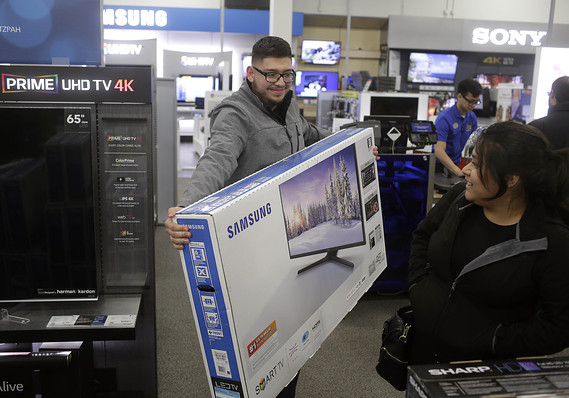Signs that the electronics retailer is gaining share
At Best Buy, the story line is no longer about defending itself against lost market share, competition from Amazon or even its very survival.
Instead, just as smaller rivals HHGregg Inc. and RadioShack filed for bankruptcy protection this year, Best Buy is growing. On Thursday, it reported a much better-than-expected Q1 profit and a 1.6% comparable sales gain, beating its own forecast for a decline.
COMPANY DATA
Revenue, store productivity, ecommerce and more
In the US, comparable sales rose 1.4%. While neither the companywide nor US sales gains are earth-shattering, they are considerably stronger than the 0.1% increase the retail sector is expected to notch, according to Retail Metrics.
On the same day, video game retailer GameStop reported comparable sales in the US declined 2.4% while Sears said its namesake chain’s US same-store sales slumped 12.4%, led by declines in categories including appliances, a category where Best Buy said Q1 comparable sales gained 4.2%.
For Best Buy, the results reflect a significant turnaround. It had a string of comparable sales declines that ran from 2011 until 2014, according to Retail Metrics data. Since then, Best Buy has registered same-store sales gains in eight out of the past 11 quarters.
CEO Hubert Joly said in March that Best Buy has gained share across the majority of its categories. That’s being borne out in third party reports. For instance, Euromonitor data showed total US electronics sales have declined in each of the past three years, but Best Buy, while lagging growth rate at some electronics sellers like Apple, has posted small gains in each of the past three years.
On the ecommerce front, where Best Buy reported a 22.5% jump in Q1 US online sales, there was some sign that it’s even taking share from Amazon. According to Slice Intelligence, Q1 online share of electronics at Amazon declined to 46.7% from 48.9% a year earlier, while at Best Buy the share increased to 8.9% from 7.8%. The Slice Intelligence data is based on online receipts from 1.63 million shoppers in its consumer panel.
Best Buy said both higher visits and conversion rates contributed to increased online sales, now representing 12.9% of its US total sales from 10.6% a year earlier.
Matching Prices, Beating Showroomers
Under Joly, who joined the company in late 2012, Best Buy has embarked on what it described as its “Renew Blue” strategy. He introduced a price matching strategy to keep from losing consumers who showroomed at Best Buy and then bought elsewhere, such as Amazon and Walmart. He also invested in training employees to reduce turnover and improve customer service.
Many marketers are seeing significant inroads to their consumers through mobile search and emerging technologies like virtual personal assistants. To help you stay up to speed for your business, we’ve curated a Roundup of articles, insights and interviews on the latest trends in search marketing.
Declaring the Renew Blue phase officially over earlier this year, Joly set a new strategy: “Building the New Blue.”
Like many other brick-and-mortar retailers and rivals from Walmart to Home Depot, Best Buy is touting a multi-channel strategy to turn its store fleet to an advantage against Amazon. The company, which shut 85 stores the past two years to start the fiscal year with 1,363 US stores, doesn’t see big change in its store count even as a wave of store closings is expected for department store and apparel retailers.
“Stores continue to be great assets,” Joly said in an earnings call on Thursday. “Our stores are profitable. There’s no material change.”
All Best Buy stores can fulfill and ship online orders from stores. That allows the company to potentially save on “last-mile” delivery costs. Joly also is revamping the store’s mobile phone departments, including staffing them with specially trained clerks who can help consumers who may have trouble deciding between a myriad of phone plans and device options.
Expanded service offerings are another weapon Joly plans to use against Amazon. The company now features “Best Buy Smart Home” service to send its staff to customers’ homes to install things including “smart” doorbells and lighting. After a test in Canada, Best Buy is testing in the US a 24×7 tech support service that fixes electronics–including items that weren’t bought at Best Buy. Best Buy plans to roll out nationwide an in-home advisory program offering free consultation for products and services.
Best Buy isn’t oblivious to the challenges facing an industry that’s heavily dependent on releases of hot products like Nintendo Switch to boost sales quarter to quarter. The sector, with products like TV, also has undergone deflationary pressure while demand for PCs and tablets waned. And it faces the possibility of increased shipping costs tied to rising online sales.
As online sales increase and consumers demand ever faster service, the company remains alert, said CFO Corie Barry on the earnings call. There’s “inherent pressure.”

